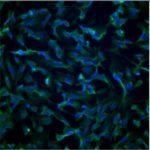Link to Pubmed [PMID] – 18299310
Mol. Pharmacol. 2008 May;73(5):1568-77
Reversal of the multidrug-resistant (MDR) phenotype is very important for chemotherapy success. In fact, the expression of the MDR1 gene-encoded P-glycoprotein (P-gp) actively expels antitumor agents such as daunomycin (DNM) out of the cells, resulting in drug resistance. We show that upon conjugation to triplex-forming oligonucleotides, it is possible to address DNM in resistant cells (MCF7-R and NIH-MDR-G185). The oligonucleotide moiety of the conjugate changes the cellular penetration properties of the antitumor agent that is no more the target of P-gp in resistant cells. We observe an accumulation of conjugated DNM in cells up to 72 h. For more efficient delivery in the cells’ nuclei, transfectant agents must be used. In addition, the conjugate recognizes a sequence located in exon 3 of MDR1, and it inhibits its gene expression as measured both by Western blot and by reverse transcription-polymerase chain reaction.

